Matthew Blackham was born in Belper, Derbyshire, the son of Ambrose and Martha Blackham. He was baptised on 25th December 1796 at St Peter’s Church, Belper.
In December 1805, aged 9, Matthew’s parents were subject to a Removal Order and most of the family, including Matthew, were relocated from Belper to Tipton, the birthplace of his father Ambrose. However, the family soon returned to Belper.
Matthew married Matilda Storer on 17th August 1818 at St Alkmund’s Church, Duffield. Matilda, the daughter of George and Martha Storer, was born in Duffield in 1793.
In the first few years of their marriage, Matthew appears to have worked as a nailer and labourer, first living at Heage and then in Crich. Their first child George was baptised on 8 March 1819 at St Peter’s Church, Belper.
Events soon took a turn for the worse.
Matilda died in February 1822 at the age of 30. She was buried in the churchyard at St Mary’s Church in Crich on 28th February. Five months later, on 16th July, Matthew was convicted of theft at the Chesterfield Quarter Sessions.
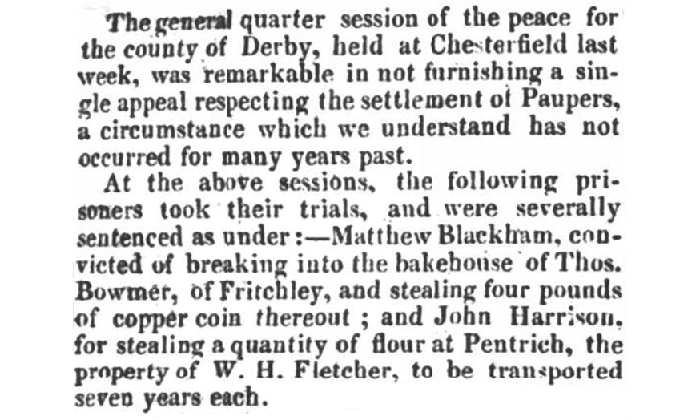
At this time George Blackham was 4 years old, his mother dead, and his father sentenced to transportation to Tasmania, facing a seven year sentence. His grandparents on his mother’s side had also died. No record has been found which shows what became of George as a child.
Matthew’s journey began in September 1822 when he was taken from the local jail to the Justitia hulk at Woolwich, where he arrived on 17th September. Prisoners were kept on board these old prison ships while they waited for their deportation to Australia, often having to do hard labour nearby.
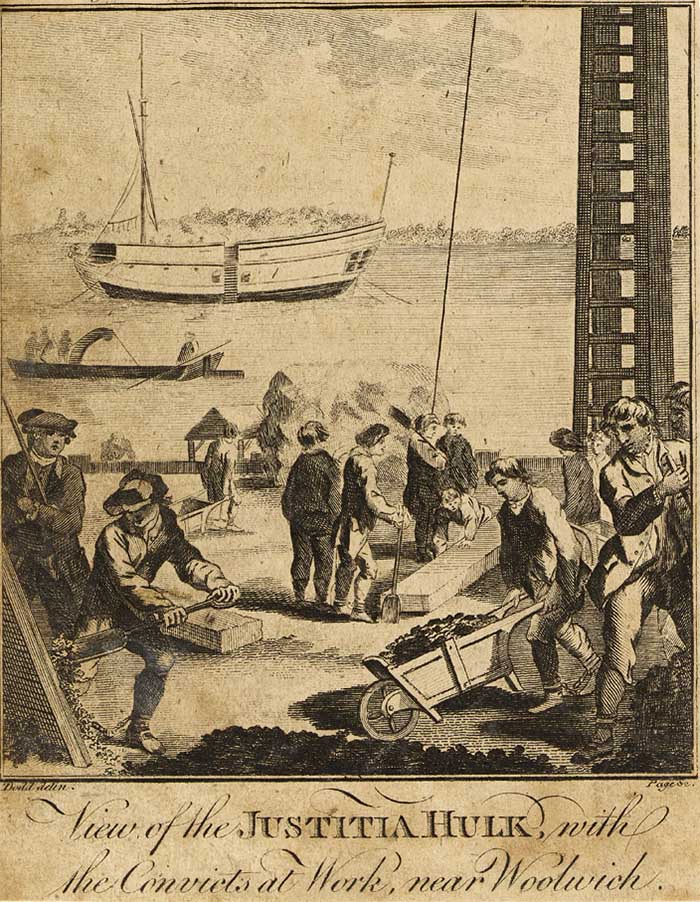 The Justitia was a 260 ton prison hulk, abolished in 1847 when it was judged to be unfit for occupation.
The Justitia was a 260 ton prison hulk, abolished in 1847 when it was judged to be unfit for occupation.
Six months later, Matthew Blackham was one of 160 convicts who left England on 18th March 1823 aboard the Competitor. Launched in 1813, this ship only made two voyages to Australia transporting convicts, and this was its first. The ship sailed via the Cape of Good Hope and arrived at Hobart Town, in what was then called Van Diemen’s Land, on 3rd August 1823. Three convicts had died during the journey.
Records taken on his arrival show that Matthew was 5ft. 3½in. tall. His hair was described as ‘DBro’ and his eyes as ‘DHaz’. It was noted that he had ‘some brown marks inside upper arm’. It was recorded that he was a nailer and that his native place was ‘Bilpool’ [being perhaps what the author heard for ‘Belper’]. Although 27, he gave his aged as 25.
A conduct record was maintained for each convict, starting from when they arrived. A summary of Matthew’s crime, comments from the local jail, and his behaviour while at the hulk, are recorded first.
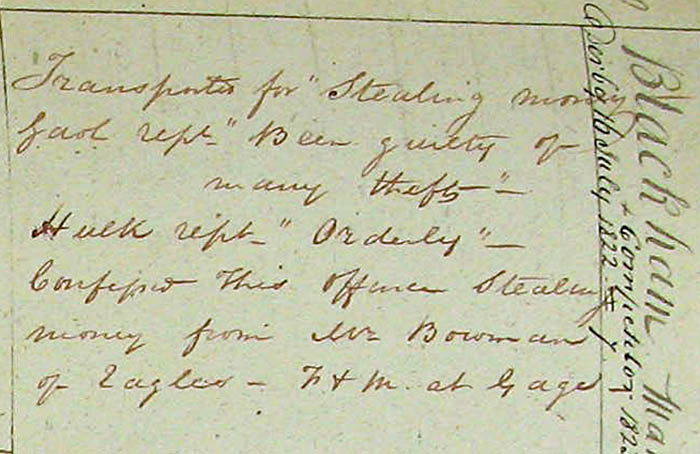 ‘Transported for “Stealing money last Sept.” Been guilty of many thefts. Hulk report “Orderly”. Confessed His offence Stealing money from Mr Bown and of 2 after. F & M at G age.’
‘Transported for “Stealing money last Sept.” Been guilty of many thefts. Hulk report “Orderly”. Confessed His offence Stealing money from Mr Bown and of 2 after. F & M at G age.’
During the first four years of his term Matthew would have been a source of labour, building roads, hospitals, and other public buildings, or set to work on a government farm. He appears to have conducted himself well. The first incident recorded in his conduct record is dated 10th January 1827 when he was reported ‘Absent from Muster this morning’.
With permission, convicts were allowed to marry and on 17th October 1827 Matthew married Alice Simkin in Hobart Town. The record of their marriage shows that both Matthew and Alice were convicts, with Matthew stated as being a bachelor and Alice a spinster. However, Alice had also been married before.
Alice Watmough was born in 1795 at Wigan and married John Simkin on 23rd December 1816. In January 1821 Alice was sentenced to seven years transportation, arriving in Hobart on 10th February 1823, where she was registered under the surname Simpkins. No details of her crime are known. Within three months of arriving she was reported for ‘misconduct, disobedience of orders and absent without leave’. Her conduct report shows further incidents almost each year, such as ‘not residing under the same roof as her mistress’ and ‘neglect of duty’.
As a reward for good behaviour, convicts could obtain a ‘ticket of leave’ when they had served four years of their sentence. These allowed the holder to find employment within a specified district, enabling them to earn a wage, although they still had to report for regular musters. On 23rd February 1828 Matthew was granted such an ‘indulgence’.
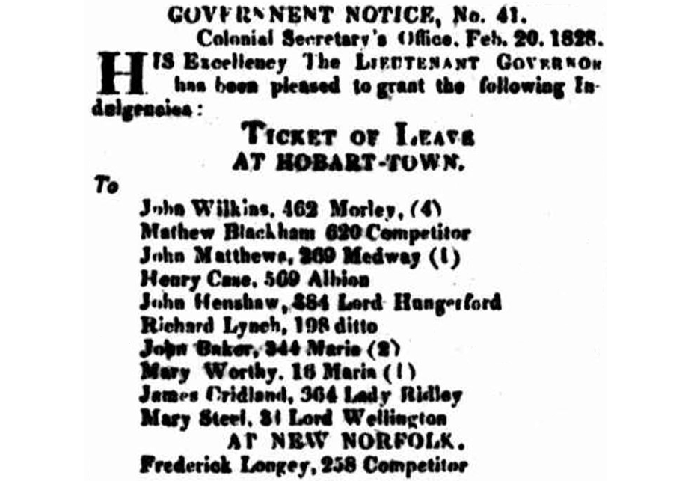
Matthew and Alice’s first son was born on 12th October 1828. He was named Ambrose after Samuel’s father, and baptised on 14th December. The record states that Matthew was a nailer.
Matthew’s conduct record only has two entries and the second is dated 16th March 1829 when he was fined five shillings for what appears to say ‘W & disy’. The last note in his record shows that he was granted a ‘Free Certificate’.

A Certificate of Freedom could be applied for when a convict had served their sentence, which required approval by the Governor. The certificate stated that the ex-convict had been restored ‘to all the rights and privileges of free subjects’ and they could seek employment or leave the colony. Matthew’s seven year term would have ended in 1829/1830, but it is not yet known when his Certificate of Freedom was issued, as he still appears to be subject to restrictions in 1833.
Matthew and Alice’s second child Mary Anne was born on 6th July 1830 and baptised 8th August in Hobart. She was followed by William, born on 6th June 1832 and baptised on 22nd July. Both baptism records state that Matthew was a nailer.
If a convict was well behaved he was usually assigned to a private settler as a farm labourer, while female convicts were usually employed as house servants.

Matthew and Alice named their fifth child John. He was born on 30th June 1834 and baptised on 27th August in Hobart.
By November 1834 Matthew appears to be a free person, having received a loan.
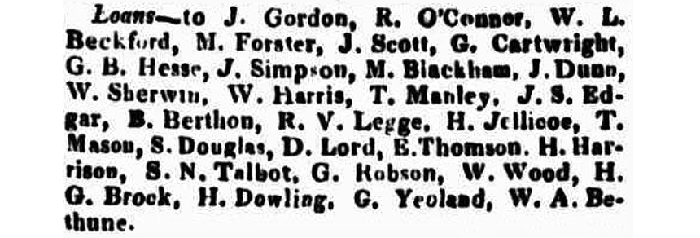
On Saturday 10th January 1835 Matthew was caught drinking in a pub after hours. However, there is no mention of a fine.
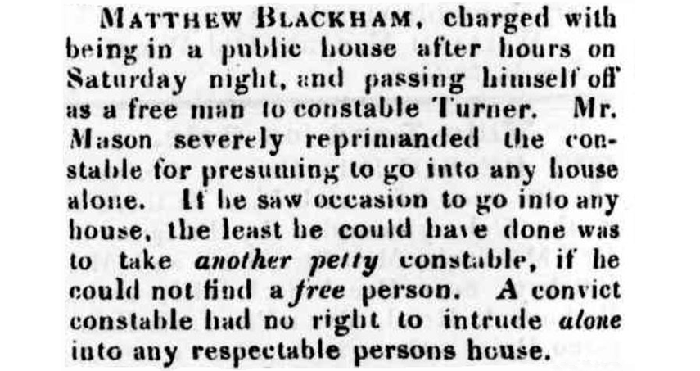
Matthew and Alice’s sixth child Harriet was born on 22nd July 1837 and baptised on 3rd October 1838. Harriett died in October 1838 aged 15 months.
On 23rd October 1839 Matthew was granted ‘one rood and five perches’ of land in Hobart Town. This was approximately ¼ of an acre, or 1,012 square metres.
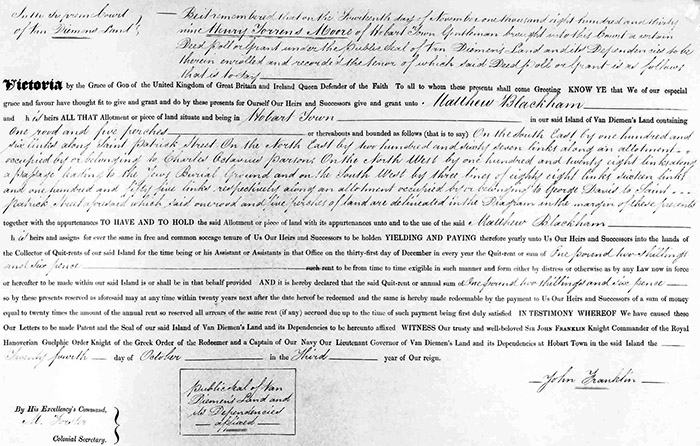
The location of Matthew’s land is described as being ‘bounded on the south east by 106 links along St Patrick-street, ... on the north west by 128 links along a passage leading to the Jews’ burial ground’.
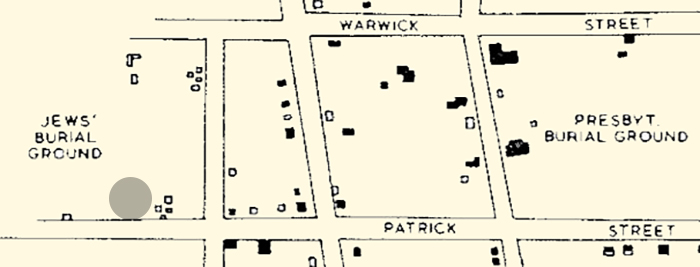 Location of Matthew’s land | 1829 Hobart Town map
Location of Matthew’s land | 1829 Hobart Town map
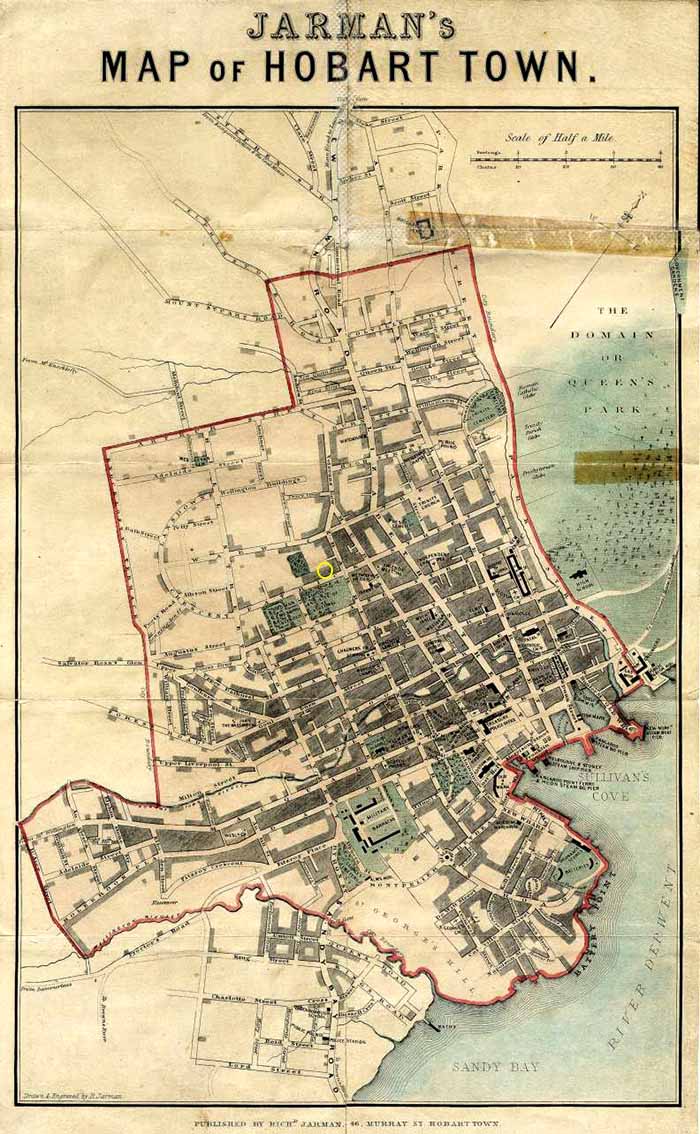 Location of Matthew’s land | 1858 Hobart Town map
Location of Matthew’s land | 1858 Hobart Town map
Matthew and Alice named their seventh child Martha after Matthew’s mother. She was born on 23rd May 1839 and baptised on 7th July. The baptism records of their previous children stated that Matthew was a nailer, but the baptism record for Martha indicates that he was working as a servant at this time. Martha died on 11th July 1841 aged 2 years and 2 months.
On 28th January 1845 Alice Blackham was fined ‘for using obscene language’.

Matthew and Alice may have had another child in June 1845 named Edward. The register of deaths in Hobart for 1846 records that Edward Blackham died on 12th February aged 8 months. Under ‘rank or profession’ is noted ‘nailor’, presumably his father’s occupation, and the cause of death was ‘bowel complaint’. The informant was ‘Alice Blackham, Patrick Street’. His death was registered on the same day that he died. Since Alice would have been 50 years old, it may be that Edward was their grandson, a child of one of Matthew and Alice’s children, but this won’t be resolved until a birth or baptism record is found.
Alice found herself at the Hobart Town Quarter Sessions of 7th April 1846 before Joseph Hone, Esq., Chairman, and Captain Moriarty.

On 1st January 1848 a census was taken for Van Diemen’s Land which recorded the number, age group, ‘civil condition’, religion and occupation of household occupants as of 31st December 1847. No names were recorded except that of the person who was the householder. The census return for Matthew Blackham shows that he was a householder on Patrick Street, being the ‘proprietor’. The house is recorded as being built of wood, complete, and inhabited with two other persons, both of whom were ‘free’. Matthew told the census enumerator that one occupant was a boy aged under 2 years, having been ‘born in the Colony’, while the other two occupants (himself and Alice) were between 45 and 60 years old, were married, and classed as ‘Other Free Persons’ (i.e. not born in Tasmania, and not having arrived ‘free’). The religion of all three occupants was recorded as Church of England. Under occupation, Matthew marked himself in the category of ‘Land Proprietors, Merchants, Bankers, & Professional Persons’.
The name of the boy aged under 2 years old on the 1848 census is unknown. I have not found a birth or baptism record for any child with the surname Blackham born between 1846 and 1848 in Tasmania. One possibility is that he was their grandson, perhaps from their daughter Mary Anne.
Matthew Blackham died on 10th June 1854 aged 58. No report of where he was buried has been found. It is likely that Matthew was buried in one of the Hobart Town cemeteries but in 1872 Cornelian Bay Cemetery was opened after the four cemeteries in town were condemned as health hazzards. Some of these graves were moved to this new cemetery.
It is not yet known when Alice died. The stories of their four children; Ambrose, Mary Anne, William and John, are also not yet known. George Blackham, the son Matthew had to leave behind in England, lived to be 57: he was admitted to Belper Union Workhouse, most likely as a patient, on 8th February 1876 and died two weeks later.
Matthew Blackham was my great-great-great-great-granduncle.